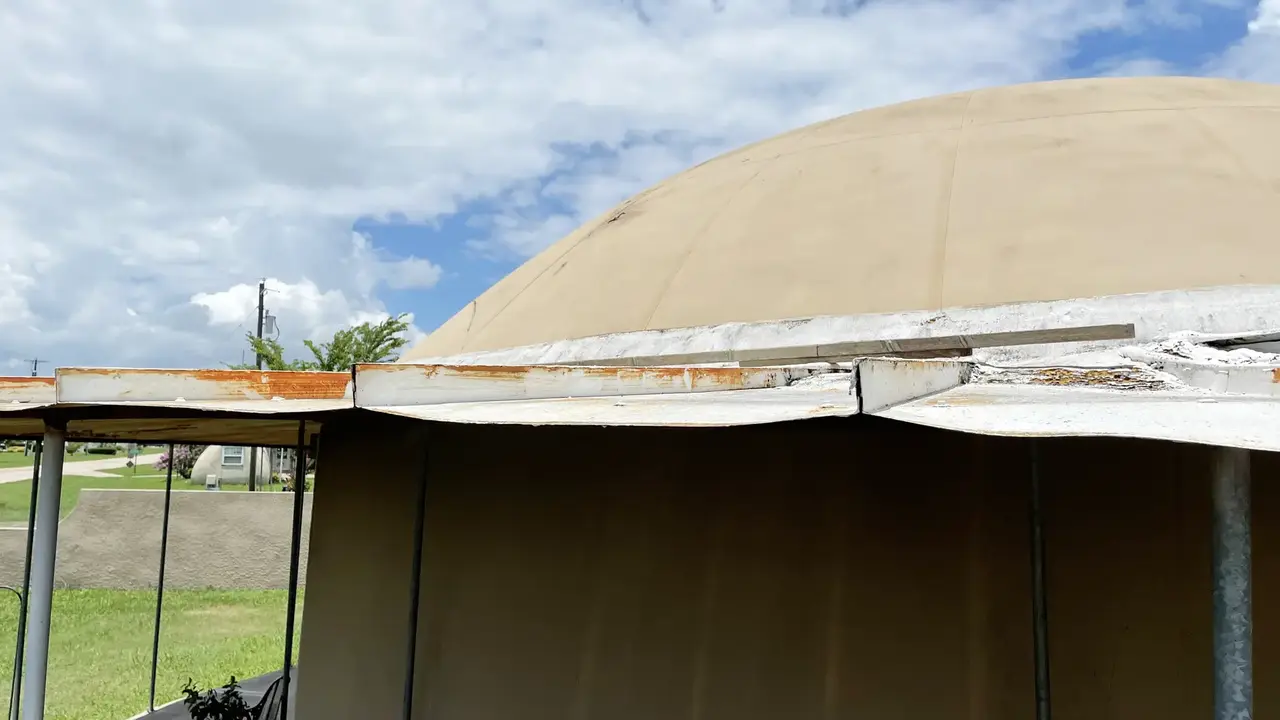Recoating Due Sorelle—A Home at Monolithic's Headquarters Goes From Bad to Fab

This 32-foot diameter home (named Due Sorelle) looks beautiful with its new coating and patio cover. The home is located at Monolithic’s headquarters in Italy, Texas and was designed by my mother and two of my sisters. It hadn’t been repaired or coated in almost 20 years. Don’t wait like we did! We recommend recoating your dome every 10 years.
Mike South
In 2004, with the help of our mom, Judy South, two of my sisters designed and planned the construction of a 32-foot-diameter Monolithic Dome home that they named Due Sorelle. Built on a 2-foot-high stemwall, this home’s 804-square-foot interior includes two bedrooms and one bath. It’s a great little house with a surprisingly large living room and kitchen.

Due Sorelle is a two-bedroom, one-bath home with a dedicated laundry space, a large and sunny eat-in kitchen, and a big living room. Lots of clever storage is built into this floorplan.
Monolithic

This is what 20 years of Texas sunshine and wild rainstorms can do to the exterior Airform and auxiliary elements of a dome when not properly maintained.
Why did this dome need to be recoated?
All Monolithic Domes need regular maintenance and coating. The Airform used in construction stays on the dome’s exterior and acts as a roofing membrane, but it doesn’t last forever. We recommend coating your dome every ten years. This home’s exterior hadn’t been touched in 20 years! Needless to say, this home desperately needed a fresh coating and a new awning. Some areas on the dome’s exterior needed patching where the sun had burned through the outer membrane.

The spots and arch on the dome are patches we placed where the Airform had eroded completely away. If we had been keeping up with coating this dome every 10 years, the patching wouldn’t have been necessary.
Mike South
The first step to fixing these problems is to ensure there’s no water under the roofing membrane. It can be a challenge to know if it’s completely dry under there, so we developed something we call a “vent.”
These vents are installed underneath a thick patch like a liquid Band-Aid. This allows us to coat the dome while allowing any water vapor to escape—if it’s there. We don’t expect this solution to work for domes where the Airform may have a lot of water trapped under it. It’s only appropriate for instances like this where the structure roofing membrane was getting old but was mostly intact, with just a few places where patching was required.

Our guys apply the final coat of the Gaco acrylic coating. The darker patch is the same material, but a different color we happened to have on hand and which we used as a primer to ensure the patches and vents wouldn’t be visible through the lighter-colored final coat.
Mike South
After patching and installing the vents, we tested how well the coating we planned to use adhered to the existing substrate. We did this using one of our adhesion test kits—which we have for sale. We applied two complete coats once we verified that our coating would adhere well.
For this project, we used a Gaco acrylic coating. We are now dealers for this product and plan to use it on many coating jobs coming down the pike. Contact us if you’d like to order some. We sell the coating, the test kits and all the supplies needed to repair the substrate.
Why we chose an acrylic coating
Why did they choose acrylic coating? It is hard to overstate how much research we have done regarding coatings, repair and maintenance of Monolithic Domes. For the past 40+ years, we have tried every type of coating available. After buying into promises made by expensive and hard-to-apply coatings, we learned (sometimes the hard way) that those promises almost always fall short. Many expensive coatings don’t last longer than what we used here and cost twice as much.
We use this acrylic coating because it is affordable and easy to apply. It has a lifespan of about ten years. At or before the ten years are up, we’ll have to simply apply another coat. It’s this easy maintenance that makes this coating the most attractive. It’s the least expensive of all the coatings we’ve tried that still lasts a long time.
If you are a dome owner who hasn’t done any maintenance to the exterior of your building in the past 5 to 7 years, have your dome inspected, washed and recoated if needed. Call us at (972)483-7423 if you want us to do it for you. The recoating will be less expensive and easier if the first layer has not entirely eroded away.